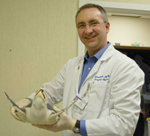|
|

|
MUSC aids rare sea turtle suffering from head injury
|
by Melissa Lacas
Public Relations
Myrtle
was swimming along, minding his own business when something badly
banged up his head last fall. The 6-pound Kemp’s Ridley turtle would
have died without his rescue and treatment by MUSC and the Sea Turtle
Hospital of the South Carolina Aquarium in Charleston.
The medical adventure for Myrtle the Turtle, due to the slash on his
face, was guided by the staff veterinarian at the S.C. Aquarium. The
Kemp’s Ridley sea turtle is one of the smallest known sea turtles and
the most endangered among all marine turtles.
 Dr.
Edward Jauch holds his new favorite patient. “Myrtle was a nice
turtle who tolerated the MRI better than most of our patients.” Jauch
said. Dr. Aquilla Turk and Dr. Paul Morgan were also on the MRI team
that gave Myrtle his first MRI. Dr.
Edward Jauch holds his new favorite patient. “Myrtle was a nice
turtle who tolerated the MRI better than most of our patients.” Jauch
said. Dr. Aquilla Turk and Dr. Paul Morgan were also on the MRI team
that gave Myrtle his first MRI.
“The
cause of the trauma is unknown and Myrtle isn’t talking,” quipped Shane
Boylan, DVM, S.C. Aquarium staff veterinarian. Staff suspect a boat
propeller struck Myrtle’s head.
“The damage completely destroyed the left nasal cavity and rhamphotheca, which is the left side of the ‘beak’,” Boylan said.
When Myrtle was brought into the turtle hospital, Boylan was unsure of
the success rate for survival for the little fellow. “The avascular
nature of the wound did not leave much room for hope.”
Although it was a surgical risk given Myrtle’s trauma and blood loss,
he was anesthetized upon arrival at the turtle hospital to alleviate
pain and to try to save as much tissue and bone as possible, Boylan
said. He used surgical wire to help juxtapose the remaining fragments
of Myrtle’s cranium.
The surgery was a success, but as
Myrtle’s head injury continued to heal, something was amiss. Trauma can
create positive buoyancy in sea turtles due to a number of reasons such
as infections leading to gas in distended intestines, tears in the
lungs releasing gas to the coelom (a fluid-filled cavity found in
certain animals), and idiopathic hyper-inflation. In other words, the
trauma created gas in his turtle body, which disrupted his natural
ability to dive and stay submerged long enough to get food.
 Myrtle,
a 6-pound endangered Kemp’s Ridley sea turtle, receives an MRI at
MUSC’s Center for Advanced Imaging Research on March 13. Myrtle suffers
from head trauma and was rescued by the S.C. Aquarium last fall. Myrtle,
a 6-pound endangered Kemp’s Ridley sea turtle, receives an MRI at
MUSC’s Center for Advanced Imaging Research on March 13. Myrtle suffers
from head trauma and was rescued by the S.C. Aquarium last fall.
Radiographic
detail could not delineate between hyper-inflated lungs or
coelomically-trapped gas. Myrtle needed an MRI to determine the
location of the gas so Boylan could determine the best approach, but
since the Turtle Hospital isn’t equipped with MRIs, they
turned to MUSC for help.
On March 13, MUSC administered an MRI on the turtle using its new
Siemens 3T Trio scanner housed in the university hospital’s Center for
Advanced Imaging Research.
Emergency Medicine’s Edward Jauch, M.D., and radiologists Aquilla Turk,
D.O., and Paul S. Morgan, Ph.D., formed the MRI team on the unusual
patient.
“Myrtle was a nice turtle who tolerated the MRI better than most of our
patients,” Jauch admitted. “Luckily, these are small creatures and once
out of the water, they are very docile. Their hearing is adapted to a
different environment, so MRI sounds will likely not bother it once
acclimated.”
The size and shape of the turtle made scanning him easier, the radiologists said.
“Fortunately, the turtle was a similar size to a human head and so was
extremely compatible with the MRI scanner,” Morgan said. “Myrtle also
stayed very still, which helped us take some detailed pictures.”
The MRI was instrumental in localizing the buoyancy to the lungs, and
revealed the positive buoyancy is not due to internal trapped gas. This
discovery avoided the need for surgical exploration, Boylan said.
“MUSC has been fantastic in lending their time and resources to helping
this endangered Kemp’s Ridley,” he added. “We really appreciate all the
effort.”
To account for his over-buoyancy, Boylan and his team of marine experts
outfitted Myrtle with a system of weights that are enough to enable him
to control his dives to hunt for food, but not so heavy that he can’t
come up for air.
“His recovery has been nothing short of remarkable,” Boylan reported.
“Myrtle, or ‘Tony Montana’ as I respectfully call him due to his new
facial feature, has been undergoing weight belt therapy for a few
months. There is mild improvement in his diving ability, but this type
of therapy can take months.”
To learn more, and keep up with the progress and therapy of Myrtle and
his other recovering marine friends at the S.C. Aquarium, visit
Myrtle’s blog at http://www.scaquarium.org/STR/blog/strblog.html.
Friday, March 27, 2009
|
|
|




